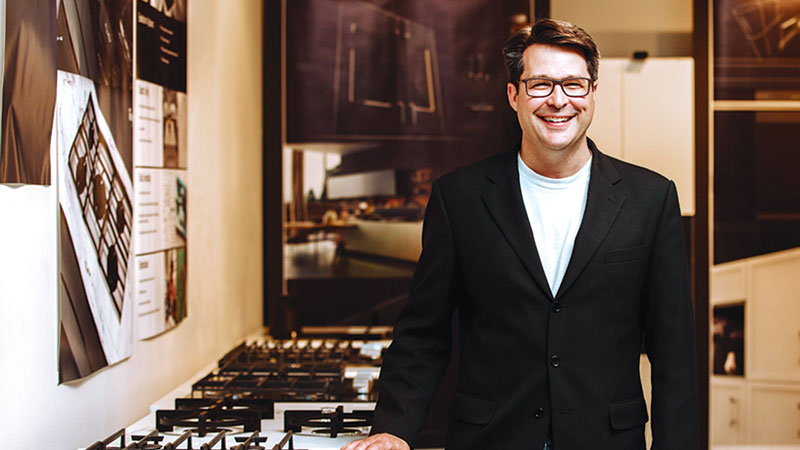A Q+A with Leif Norland, Global Design Director for Cooking at Whirlpool Corporation.
How do you approach design from your position at Whirlpool?
Whirlpool represents many brands around the world, including Maytag, Jenn-Air, Amana, and KitchenAid, just to name a few. I head up the design of all of Whirlpool’s cooking products globally.
My team and I spend a lot of time on what we call “assisted cooking.” As designers, our mantra is to help our consumers deliver more consistent results to the table. Imagine the ability to create the perfect custard, for example. When you make a custard, you have to use a wooden spoon, and, as you stir, you have to watch how the bubbles cling to the spoon when you wipe them off. That’s how you tell a custard is done—it’s not easy. Our goal is to create solutions that empower our consumers to deliver that chef-level result every time. We want you to benefit from a chef’s 30 years of experience in just two minutes.
What is the best part of your job?
I thoroughly enjoy learning about cultures through their cuisine. When Whirlpool went global, I wanted to head the cooking division because, to me, the kitchen is the central hub of the household, and the chef is the hero of the kitchen. Think about the KitchenAid stand mixer; when that mixer gets switched on, you know you’re not going to be eating something bland like broccoli—there is usually a sweet reward.
What does a typical day look like for you?
I never know where the day is going to go. Working globally, an opportunity or a problem could pop up at any time, even overnight while I’m asleep. In the morning, after about four cups of espresso, I video-call my team globally. First, I take a look at what has happened overnight in Asia to see if there are any issues. By then, Europe’s been online for several hours, so I usually focus there next. Later, I sit with my team and try to come up with new ideas. When we come up with a new product, we hand-carve models out of Styrofoam and then 3D print precise models. We even do our own testing and validation in on-site usability labs. Design is all about failing fast and refining ideas to deliver maximum quality, durability, and usability.
How do you find inspiration for new products?
My team and I approach design from a connoisseur’s perspective. If someone on my team is working on a coffee maker, I want them to know everything there is to know about coffee. They have to know the brewing process, the boiling temperature, and how it is best enjoyed. So, to get new ideas, we conduct observational research in the homes of actual customers. Understanding the context of the kitchen is crucial, especially when it comes to other cultures. We want to design our products so that you feel like they’re a part of your home.
Which past project are you most proud of?
I used to head the design team for our KitchenAid brand. I would say that the brand is most known for the iconic stand mixer.
It is a premium product that sells all around the world. When people buy it, they’re really buying a little piece of America. But the most striking thing about the mixer is its distinctive Streamline Moderne design style. You know right away that it’s a KitchenAid. So, when I got the job to head that design studio, the first thing I did was create a toaster in the same style as the blender. However, the problem with being a designer is that when you finish a project, it becomes a part of the past. Afterward, you know what the product could be, and you know where you want to go next. In the mind of a designer, by the time you’re done with an idea, it’s already dated.
How do you keep your creativity sharp?
Because of the diversity of my discipline, I need to stay sharp in multiple areas. To keep up my mechanical aptitude, I fix and repair motorcycles in my spare time. Likewise, trying out new recipes keeps me in the game of cooking. I love the artistry that can happen in the kitchen.
What advice would you give to an aspiring designer?
Always seek to understand and know your audience above all else. But first, you need to master your craft at the highest level. You have to build muscle memory through repetition. During the first five years out of college, you have to practice that all day, every day. At the beginning of your career, it’s all about working hard, not working smart. Through working hard, you understand how to work smarter. Think of it like saving for your retirement; if you start early, the payoff will be big, but if you start late, you will have to catch up eventually.

